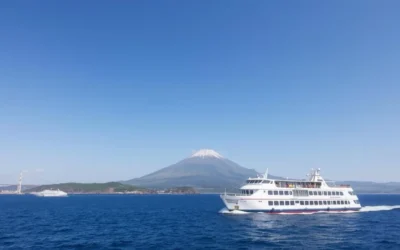✓ Accommodations✓ Flights✓ Rental Cars
Planning a trip to Hiroshima Prefecture can be a delightful experience, especially when you’re aware of the seasonal variations that this beautiful city has to offer.
With four distinct seasons, you’ll have a unique experience throughout the year. Understanding the temperature patterns, rainfall considerations, and crowd levels will help you make an informed decision about the best time to visit.
Whether you’re looking forward to cherry blossom viewing in spring or enjoying the colorful fall foliage, knowing what to expect from the weather will enhance your travel experience.
The Seasonal Charm of Hiroshima Prefecture
The charm of Hiroshima Prefecture lies in its distinct seasons, each bringing its own weather and beauty. As a city in southern Japan, Hiroshima enjoys a climate that is generally warmer and sunnier than the rest of the country, making it a popular destination throughout the year.
A City of Four Distinct Seasons
Hiroshima’s location means it experiences four clear seasons, with significant changes in weather and natural beauty. You can expect mild temperatures and famous cherry blossoms in the spring, hot and humid weather in the summer, comfortable temperatures and spectacular foliage in the fall, and mild winters with illumination festivals.
- Experience the transformation of Hiroshima throughout the year, with each season offering unique charm and character.
- Enjoy mild temperatures and cherry blossoms in spring, creating picture-perfect moments.
- Summer brings vibrant energy with festivals and outdoor activities, despite the heat and humidity.
- Fall offers spectacular foliage under comfortable temperatures.
- Winter reveals a serene side of Hiroshima with mild temperatures and illumination festivals.
Why Weather Matters When Planning Your Visit
Understanding these seasonal variations helps you plan your trip according to the experiences you value most, whether that’s cultural events, natural beauty, or comfortable sightseeing conditions. By considering the weather and season, you can make the most of your visit to this vibrant city in Japan.
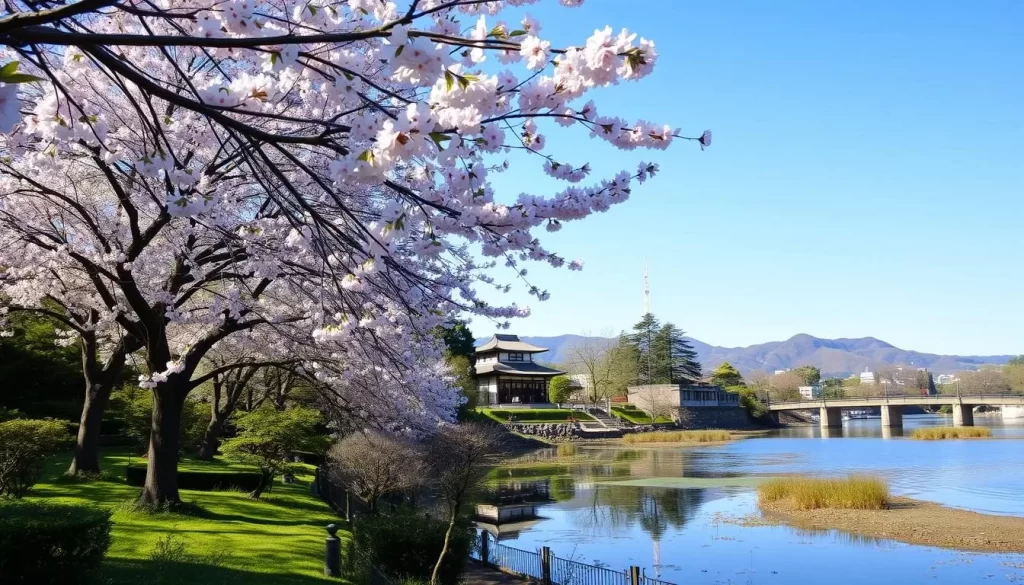
Spring in Hiroshima: Cherry Blossoms and Mild Weather
Spring in Hiroshima is a breathtaking experience, with the city transforming into a pink paradise as cherry blossoms bloom. The season brings a welcome change from the cold winter months, with mild temperatures and vibrant festivals that showcase the city’s culture.
March: Early Spring Transitions
In March, Hiroshima begins its transition into spring, with temperatures gradually warming up. Early-blooming flowers start to appear, signaling the end of winter. It’s a great time to enjoy the outdoors as the city starts to come alive with the sights and sounds of the season.
April: Peak Cherry Blossom Season
April is the peak month for cherry blossoms in Hiroshima, with iconic locations like Peace Memorial Park and along the Ota River becoming a photographer’s dream. The city’s famous cherry blossoms attract visitors from all over the world, creating a lively atmosphere.
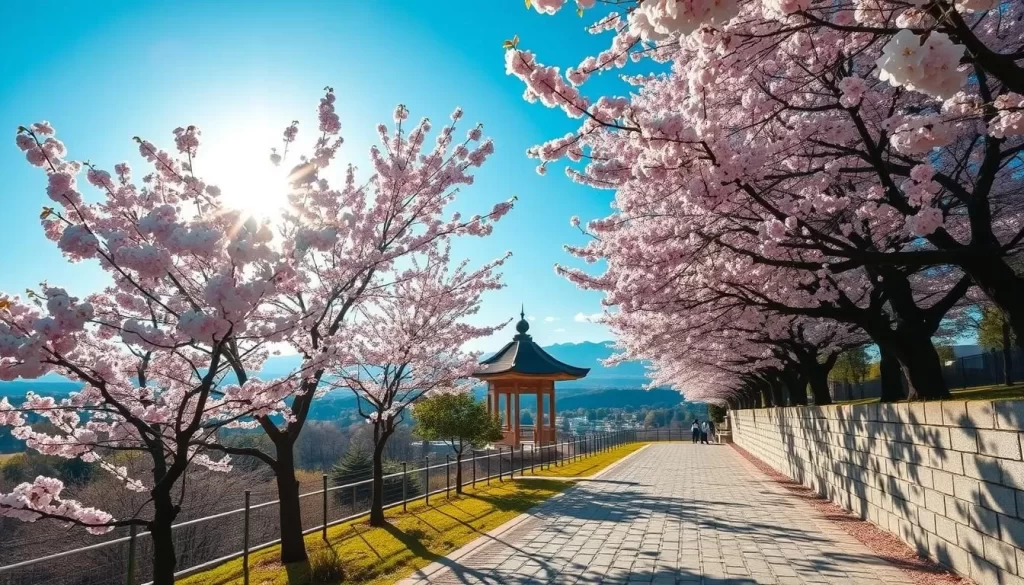
May: Perfect Weather and Fewer Crowds
May offers perfect weather conditions, with warm days, low humidity, and fewer crowds after the cherry blossom season. It’s an ideal time to explore Hiroshima’s cultural heritage and enjoy the city’s outdoor spaces.
Must-Visit Spring Festivals
Spring in Hiroshima is not just about the cherry blossoms; it’s also a time for vibrant festivals. The Hiroshima Flower Festival in May is a highlight, featuring parades, performances, and food stalls that celebrate the region’s cultural heritage.
| Month | Weather | Events |
|---|---|---|
| March | Warming temperatures, early blooms | Early spring flower viewing |
| April | Peak cherry blossom season | Hanami parties, cherry blossom viewing |
| May | Warm days, low humidity | Hiroshima Flower Festival |
As you plan your visit, consider the unique experiences each month offers, from the beauty of the cherry blossom season to the cultural richness of the spring festivals.
Summer in Hiroshima: Navigating Heat and Rain
Summer in Hiroshima brings a unique blend of challenging weather conditions and memorable experiences. The season is characterized by hot and humid days, alongside significant rainfall during the rainy season, known as tsuyu.
June: Beginning of Rainy Season
In June, Hiroshima enters its rainy season, with frequent showers alternating with sunny periods. This creates lush green landscapes throughout the prefecture, making it a great time for nature lovers to visit.
July: Peak Heat and Humidity
July brings peak summer heat and humidity, with temperatures often climbing into the high 80s°F (around 30°C). Exploring the city during early morning or evening is recommended for comfort.
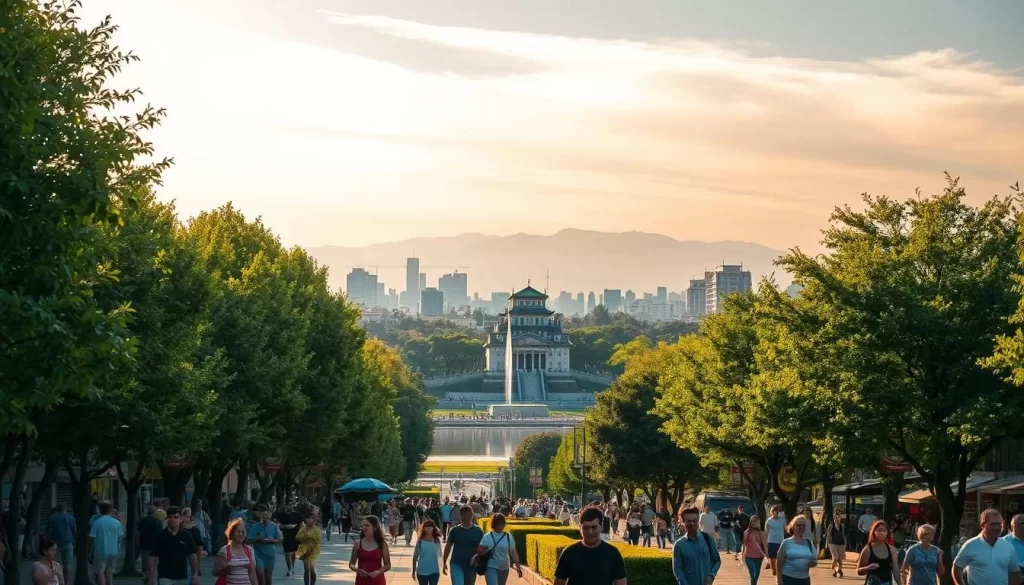
August: Hot Days and Memorial Events
August continues the hot weather pattern but is also significant for memorial events, particularly the Peace Memorial Ceremony on August 6th. The toro nagashi (floating lantern) ceremony is a poignant moment, illuminating the Motoyasu River.
Summer Festival Highlights
Despite the challenging weather, summer offers unique cultural experiences, including festivals like the Toukasan Festival in June and numerous fireworks displays along the coast. To enjoy Hiroshima’s summer attractions comfortably, it’s essential to stay hydrated, wear breathable clothing, and carry a portable fan.
Fall in Hiroshima: Colorful Foliage and Comfortable Temperatures
Hiroshima’s fall season is a treat for the senses, with comfortable temperatures and stunning foliage. The city’s fall foliage is particularly noteworthy, as the trees turn vibrant shades of red, orange, and gold.
September: Transition from Summer Heat
In September, Hiroshima transitions from the intense summer heat to more moderate weather, making outdoor exploration much more comfortable. You’ll feel a welcome relief as the temperatures become ideal for walking around the city.
October: Prime Fall Foliage
October brings the prefecture’s fall foliage to its spectacular peak, with maple trees turning brilliant shades of red and gold, especially in mountainous areas like Miyajima Island and Sandankyo Gorge.
November: Crisp Days and Cultural Events
November offers crisp, clear days with blue skies, creating the perfect backdrop for Hiroshima’s autumn colors and outdoor activities. The season also brings unique cultural events like the Saijo Sake Festival.
Autumn Festivals and Food Celebrations
The autumn season in Hiroshima is filled with festivals, including the Onomichi Betcha Festival, which shares the city’s deep traditions. You’ll also find special seasonal foods, such as matsutake mushrooms, persimmons, and chestnuts, featuring prominently in local cuisine.
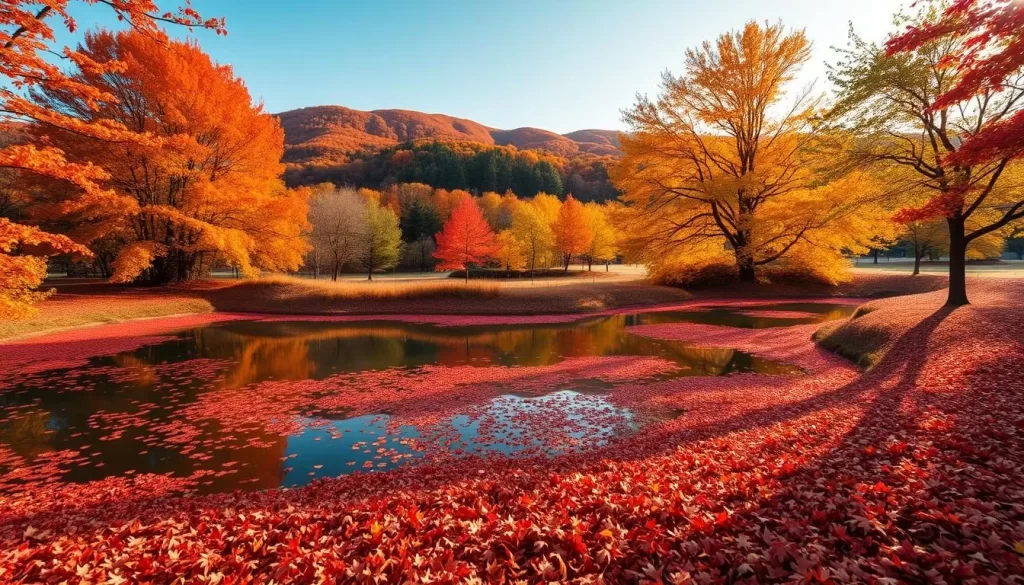
- Enjoy comfortable temperatures around 70°F (21°C), ideal for exploring the city.
- Experience the peak of fall foliage in October, with vibrant colors across the prefecture.
- Participate in cultural events and festivals that celebrate Hiroshima’s autumn.
Winter in Hiroshima: Mild Climate and Festive Atmosphere
Experience the softer side of Hiroshima during winter, with its gentle climate and captivating festivities. Unlike northern Japan, Hiroshima doesn’t get extremely cold, making it an attractive destination even in the winter months.
December: Winter Illuminations
December is a magical time in Hiroshima, thanks to the Hiroshima Dreamination, a dazzling illumination festival that transforms the city into a winter wonderland. The event features thousands of lights and decorations, creating a festive atmosphere that’s perfect for families and couples alike.
January: New Year Celebrations
In January, Hiroshima comes alive with New Year celebrations at shrines and temples across the prefecture. Visitors can experience traditional Japanese customs and rituals, offering a unique cultural insight into the local way of life.
February: Winter Festivals and Oyster Season
February marks the peak of oyster season in Hiroshima, with the Miyajima Oyster Festival being a highlight. It’s a great time to enjoy fresh seafood, and for those interested in winter sports, the northern parts of Hiroshima Prefecture offer skiing and snowboarding opportunities.
| Month | Events | Weather |
|---|---|---|
| December | Hiroshima Dreamination | Mild, with average temperatures around 4°C (39°F) |
| January | New Year Celebrations | Cool, with occasional snowfall |
| February | Miyajima Oyster Festival, Winter Sports | Crisp, with temperatures ranging from 2°C to 10°C (36°F to 50°F) |
Winter in Hiroshima offers a serene and less crowded experience, allowing visitors to explore popular attractions like Miyajima Island and the Peace Memorial Park at a relaxed pace. Whether you’re interested in cultural events, fresh seafood, or simply enjoying the mild winter weather, Hiroshima has something to offer.
Hiroshima Prefecture, Japan: Best Months for a Weather-Savvy Trip
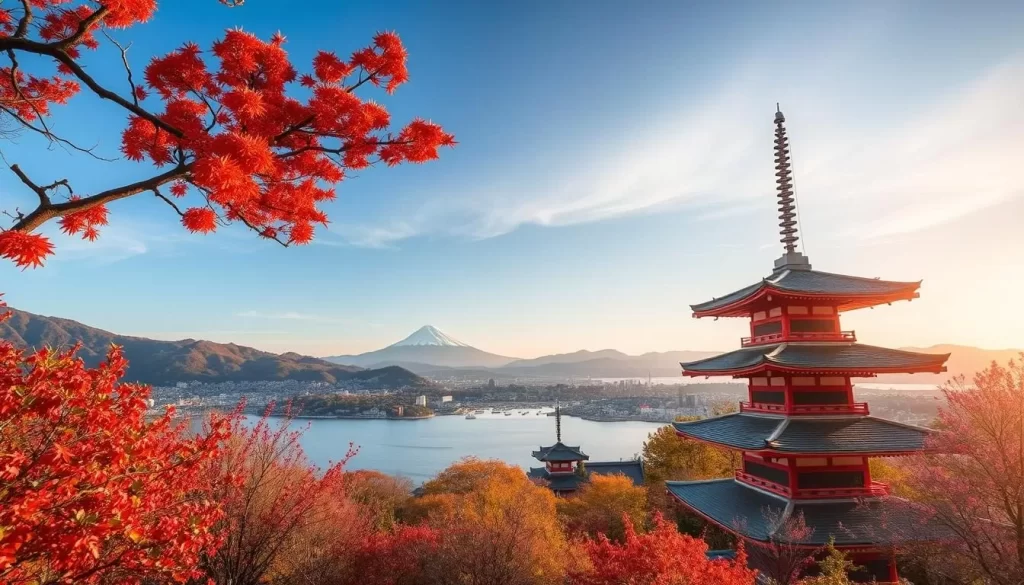
To experience Hiroshima at its best, it’s essential to know the best months to visit based on weather conditions. The ideal time to plan your trip is when the weather is pleasant and there are fewer tourists.
May: Spring Perfection
May offers the perfect balance of pleasant temperatures, blooming flowers, and fewer crowds after the peak cherry blossom season has ended. It’s an ideal time to visit Hiroshima for those who prefer milder weather.
September to November: Fall Sweet Spot
The fall months from September through November provide you with comfortable temperatures, stunning foliage, and cultural festivals without summer’s heat or winter’s chill. This period is considered the best time to enjoy Hiroshima’s outdoor attractions.
Weather Considerations for Your Travel Style
Your travel style and priorities should guide your timing decision. For instance, photographers might prioritize cherry blossom season despite crowds, while budget travelers might prefer the shoulder seasons. If you’re sensitive to hot and humid conditions, you’ll want to avoid Hiroshima’s summer months.
Here are some key considerations for your trip:
– You’ll find May offers pleasant temperatures and fewer crowds.
– The fall months provide comfortable temperatures and stunning foliage.
– Your travel style should guide your timing decision.
– Avoid Hiroshima’s summer months if you’re sensitive to heat and humidity.
– Travelers interested in memorial events might plan around August 6th.
– Consider your itinerary when planning your trip timing.
Monthly Weather Breakdown: Temperature, Rainfall, and Daylight
To make the most of your visit to Hiroshima, it’s essential to grasp its climatic conditions throughout the year. Understanding the temperature, precipitation, and daylight hours helps you pack right and make smart choices for your visit.
Temperature Patterns Throughout the Year
Hiroshima’s temperature varies significantly throughout the year. You’ll experience the warmest temperatures in July and August, with averages reaching 82-84°F (28-29°C), while January is the coldest month with temperatures around 40°F (4°C).
Rainfall and Humidity Considerations
The rainfall pattern in Hiroshima shows July as the wettest month with about 10.2 inches of precipitation, while December is the driest with only 1.6 inches. The rainy season from June to mid-July brings frequent showers, but it doesn’t typically last all day.
Daylight Hours by Season
Your daylight hours will vary significantly throughout the year, from about 10 hours in winter to nearly 14.5 hours during summer months. This variation affects how much sightseeing time you’ll have each day.
| Month | Average Temperature (°F) | Rainfall (inches) | Daylight Hours |
|---|---|---|---|
| January | 40 | 2.2 | 10 |
| July | 82 | 10.2 | 14.5 |
| December | 45 | 1.6 | 10 |
Avoiding Crowds: Tourist Seasons in Hiroshima
To make the most of your visit to Hiroshima, it’s essential to know when the crowds are likely to be at their peak. The city’s popularity as a tourist destination means that certain times of the year are busier than others.
Peak Tourist Periods to Know
The heaviest crowds in Hiroshima are during cherry blossom season (late March to early April) when visitors flock to famous viewing spots like Peace Memorial Park and Hiroshima Castle. Summer months (July-August) also bring a peak in tourism, particularly around the August 6th Peace Memorial Ceremony.
Finding the Sweet Spot: Good Weather with Fewer Tourists
- Late May and early June offer a good balance between pleasant weather and manageable crowd levels.
- Late September through October is another period with pleasant conditions and fewer tourists.
Popular Events That Draw Crowds
Major events like the Hiroshima Flower Festival (May), Toukasan Festival (June), and the Saijo Sake Festival (September) draw significant crowds. Booking accommodations in advance is essential if your trip coincides with these dates.
Packing Guide for Hiroshima’s Changing Seasons
Packing for Hiroshima requires consideration of the city’s distinct seasonal weather patterns. To ensure a comfortable and enjoyable trip, it’s crucial to adjust your wardrobe according to the time of year you plan to visit.
Spring and Fall: Layering Essentials
During spring and fall, Hiroshima experiences mild temperatures with cool mornings and warm afternoons. Packing layers is essential, including long-sleeved shirts and cardigans that can be added or removed as needed.
Summer: Beating the Heat and Rain
Summer in Hiroshima is characterized by hot and humid weather, with a rainy season in June and July. It’s advisable to pack light, breathable clothing and rain gear, such as umbrellas and waterproof footwear.
Winter: Staying Comfortable in Mild Cold
Winter in Hiroshima is relatively mild but can still be chilly. Bringing warm clothing like down jackets and sweaters, along with boots, will keep you comfortable during your visit.
| Season | Weather | Packing Essentials |
|---|---|---|
| Spring/Fall | Mild, variable temperatures | Layers, long-sleeved shirts, cardigans |
| Summer | Hot, humid, rainy | Light, breathable clothing, rain gear |
| Winter | Mild cold | Warm clothing, down jackets, boots |
Conclusion: Planning Your Weather-Perfect Trip to Hiroshima
Whether you’re drawn to cherry blossoms or fall foliage, understanding Hiroshima’s seasonal weather is key to a memorable trip. The city’s climate varies significantly across the year, offering distinct experiences in each season.
You’ve discovered that the best times to visit Hiroshima are generally May and September through November, when you’ll enjoy pleasant temperatures and fewer crowds. Your decision should depend on what experiences you value most, whether it’s cultural festivals in summer or peaceful exploration in winter.
By considering the weather patterns, crowd levels, and seasonal attractions, you’re now equipped to plan a weather-savvy trip to Hiroshima Prefecture that matches your travel preferences. No matter when you visit, Hiroshima’s rich history, stunning natural landscapes, and warm hospitality will make your journey memorable.
The above is subject to change.
Check back often to TRAVEL.COM for the latest travel tips and deals.

